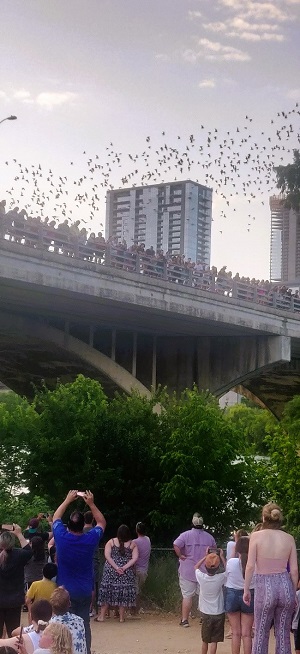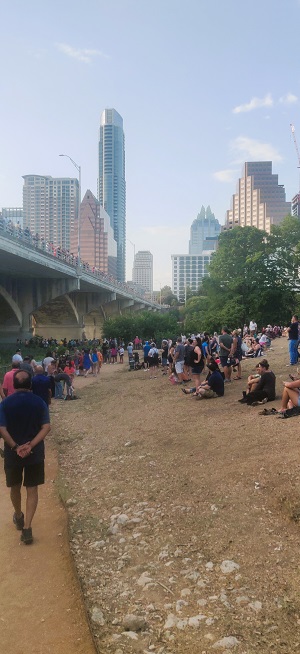Mar 31, 2025
Mar 31, 2025
by Sundar Rajan
I had the pleasure of meeting my school mates, in Austin, USA, after forty-five years, that brought nostalgic memories of our school days. It was evening and we decided to take a trek along the 'Lady Bird Lake', chatting happily. On our return, I was surprised to see people gathering in groups on the banks of the lake and a crowd was assembling on the bridge over the Colorado River, expectantly peering across the waters. Seeing my surprise, one of my friends, a resident of Austin, informed me that such evenings are a very regular feature between March and October every year, when people gather in large numbers at sunset to watch the bats fly out of their roost. It also draws a large number of tourists to witness this spectacle.
I was even more surprised as bats are generally regarded as a symbol of bad omen, across most countries, identifying with death, rebirth or other calamities while in some countries like China, it is worshipped.
 Seeing my surprise, my friend started narrating the history of the bats in Austin. These are Mexican free tailed bats and account for the largest Urban Bats. They migrate from Mexico to the US every year in Summer, between March and October and return to Mexico at the onset of winter in the US. The bridge, one of the oldest in Austin, initially named Congress Avenue bridge, crosses over Lady Bird Lake. The bridge was rechristened as Ann W Richards Congress Avenue Bridge on 16th Nov. 2006, after the 46th Governor of Texas. It is also known as South Congress Avenue Bridge. But it popularly came to be known as the Bats Bridge due to the cauldron of bats that migrate and congregate here during Summer, this being the most abundant mammal in the USA.
Seeing my surprise, my friend started narrating the history of the bats in Austin. These are Mexican free tailed bats and account for the largest Urban Bats. They migrate from Mexico to the US every year in Summer, between March and October and return to Mexico at the onset of winter in the US. The bridge, one of the oldest in Austin, initially named Congress Avenue bridge, crosses over Lady Bird Lake. The bridge was rechristened as Ann W Richards Congress Avenue Bridge on 16th Nov. 2006, after the 46th Governor of Texas. It is also known as South Congress Avenue Bridge. But it popularly came to be known as the Bats Bridge due to the cauldron of bats that migrate and congregate here during Summer, this being the most abundant mammal in the USA.
In 1980, the bridge was rehabilitated, which created ideal roosting site in the crevices underneath the bridge. The road decks in the gaps between the concrete component structures provide the ideal place to roost. Very soon, it became home to the world's largest Urban Bat Colony for the migrating Mexican free tailed bats.
Initially there was a stiff outcry from the residents, seeking bat deterrent measures from the government. In 1986, the bats were widely unpopular, and the colony was at the risk of extermination. But the residents soon embraced their seasonal visitors and the locals have adopted these mammals as neighbors. These bats are now a symbol of identity and pride in a city known for "Keeping it Weird".
This transformation was mainly due to the relentless efforts by Merlin Tuttle, founder of Bat Conservation International (BCI), who relocated to Austin and with the help of a coalition of leaders in the Austin community, the Public Health and news media, spread his persistent educational efforts successfully and reversed the public opinion about the bats and spun the bats bridge colony into a very profitable tourist attraction for Austin.
About 1.5 million bats have made this their home, each summer. It is a maternity colony, as pregnant female bats come to roost in the spring and raise their pups from mid-summer to Fall. The male bats keep away from the bridge until the pups are born. They give birth to one single baby bat. Five weeks after birth, they learn to fly and hunt insects on their own. Even though there are thousands of pups, the mummy bat can easily locate her pup in the colony.
Every evening, the bats come out of the roost, a little past sunset between 7.30 pm and 9.45 pm. It takes about 45 minutes for all the bats to exit. They form a surreal dark cloud as they ascend the sky, flying across the Lady Bird Lake, primarily to the East to feed themselves. They prey on moths, dragon flies, wasps, butterflies and ants. They consume about 30,000 pounds of insects every night. They are also efficient pollinators. Their count is more than the residents numbering around 90,000. They draw around 30,000 locals and 100,000 tourists, providing a revenue of around 8 million $ in tourism, a real economic impact.
 The bridge was swarming with people jostling for space at the parapet wall. Along the riverbanks, groups had spread some sheets and were sitting on the ground while many were standing. Most had their camera and videos ready, waiting with a touch of impatience and gazing expectantly at the undercarriage of the bridge. We too scouted round and located an ideal spot for the view and readied ourselves excitedly.
The bridge was swarming with people jostling for space at the parapet wall. Along the riverbanks, groups had spread some sheets and were sitting on the ground while many were standing. Most had their camera and videos ready, waiting with a touch of impatience and gazing expectantly at the undercarriage of the bridge. We too scouted round and located an ideal spot for the view and readied ourselves excitedly.
The other vantage points are Statesman Bat Observation Centre adjacent to the bridge, at the Roy Butler Hike and Bike Trail at the Lady Bird Lake or through boat tours from the water.
Around 8.00 pm there was a light rustle and soon everyone stood up, as the bats initially as small batches and then as a cloud started flying out of the crevices. There were cries of ecstasy and loud shouts everywhere with people clicking fervently into their cameras while some describing the recording in their videos. Very soon a cauldron of bats filled the sky. I clicked a few pictures but for the most part stood in awe as I watched the bats flying out in uniformity in a sequence, giving enough space for each other. My mind quietly connected this space with our covid times where we are asked to maintain a safe distance between one another but more often than not, we failed miserably in this aspect.
Those on the bridge watched the bats only after they came out of the roost, but they got a closer look at the bats because of the elevation. Those at the ground level watched the flight of bats from the crevices but from a distance only.
This activity has become so popular that every mid-August, the Austin Bat Fest is conducted for a week, in which the bat is the unofficial mascot. But I was not fortunate to witness the Fest as I had to leave early.
A study 'Bats and Bridges', by the Texas Dept. of Transportation in cooperation with BCI was conducted to study the building of bridges to make it habitable for bats.
The bats have become a symbol of identity and pride in Austin. For example, Austin Ice Bats minor league hockey team have adopted the bats while the song "Bats" by Kimya Dawson and rapper Aesop was inspired by the bats.
As the crowds started to melt, we too moved away from the bridge. Our gaze was repeatedly towards the sky, and we could vividly watch the cauldron of bats in flight. Though it was getting dark, the bats were visible to the naked eye even from a distance. It appeared to be a flight of fantasy.
Every morning they return about thirty minutes before sunrise. How I wish we could come back the next morning to greet the bats back to their roost on their return!
I marvel at how the bats identified initially a compact roost and how they migrate every year to their crevices. It is a wonder how they return to their home and family after their nocturnal flight while we humans even with support systems like GPS find it difficult to spot our destination. Their sense of time is admirable. They appear to be smarter than humans in some respects. Having said this, I should add here that due to the concerted efforts of a few what would have been lost to posterity has been converted into an environmental showpiece for the world to emulate.
Images by author
10-Sep-2022
More by : Sundar Rajan

|
It's a methodically written travelog and informative too. An interesting read! |

|
The last point is very true and the answer is they still live close to nature whereas we have distanced ourselves from nature. Their instincts are sharp where ours , blunted. A very interesting piece of information, presented well. Thank you for the share! |